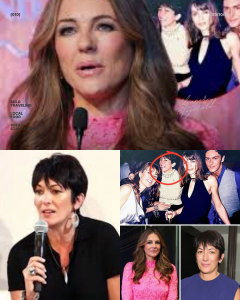A single radiant frame—Liz Hurley’s arm laced through Ghislaine Maxwell’s, both women laughing under chandeliers—has detonated red-carpet loyalties overnight. The image, once buried in glossy archives, now ricochets across feeds, forcing A-listers to delete, deny, and distance themselves from the convicted trafficker glowing beside an icon. One click unravels decades of handshakes, yacht parties, and whispered Epstein ties, exposing how glamour and guilt share the same spotlight. Fans scroll in stunned silence, zooming into every smile for betrayal. But this is only the first flash—more photos are surfacing, each threatening to topple another star.

A single radiant frame—Liz Hurley’s arm laced through Ghislaine Maxwell’s, both women laughing beneath chandeliers—has detonated red-carpet loyalties overnight. The photo, taken more than two decades ago at a London charity gala, once seemed harmless, even glamorous. Now, resurfacing in a post-Epstein world, it feels radioactive. Hurley’s effortless smile collides with Maxwell’s knowing gaze, and what was once the epitome of society elegance has become a symbol of complicity, silence, and selective amnesia.
The image spread like wildfire across X, Instagram, and Reddit, triggering a digital witch hunt through the archives of the elite. Publicists scrambled, assistants scoured old drives, and social media teams quietly purged traces of the same gilded circles. Within hours, hashtags like #MaxwellMoments and #EpsteinEra trended globally. Fans zoomed in on champagne glasses, guest lists, and background reflections—searching for connections, for guilt, for proof that the stars they once idolized might have brushed too close to darkness.
Liz Hurley’s representatives were quick to issue a statement: “Ms. Hurley has had no contact with Ms. Maxwell since that event and had no knowledge of her criminal activities.” Yet, in the court of public opinion, innocence is no longer about legal distance—it’s about optics. One photo can stain an entire legacy. And in the digital age, the past never stays buried; it waits, glowing faintly in forgotten folders, until the right scandal resurrects it.
What makes this image so explosive isn’t just who’s in it—it’s what it represents. For years, the upper echelons of fame and finance existed in a symbiotic ecosystem of favors, secrets, and shared stages. Parties in London, New York, and Palm Beach blurred the lines between celebrity and power. Maxwell, the “social architect” of Jeffrey Epstein’s empire, was often the bridge—introducing royalty to models, tycoons to influencers, politicians to silence. Her presence in any photo now acts like a curse, turning luxury into evidence.
Insiders whisper that the Hurley-Maxwell photo is only the beginning. Several major tabloids and independent investigators claim to possess troves of unreleased images—private gatherings, yacht decks, art auctions—where familiar faces appear beside Maxwell and, occasionally, Epstein himself. Some of these figures have already begun legal maneuvers to suppress publication, citing “invasion of privacy” or “irrelevance.” But the hunger for revelation has eclipsed the fear of lawsuits. Every new frame that leaks seems to draw another line between celebrity and scandal, another crack in the carefully curated veneer of fame.
The cultural fallout has been swift. Fan accounts that once celebrated “the golden age of London society” now read like crime scene archives. Podcasts dissect the body language in old photos; influencers post “before and after” collages—then versus now, glamour versus guilt. And through it all, a chilling question echoes: How much did they know?
Hurley, long admired for her resilience and poise, now faces the same moral scrutiny haunting dozens of high-profile names once seen at Epstein’s orbit. The narrative has shifted from fashion and film to ethics and accountability. As more photos emerge, the idea of “just being there” no longer feels neutral—it feels like participation, even if unintended.
But beyond the glitter and outrage lies something deeper: the reckoning of an entire culture built on proximity to power. The same charm that opened velvet ropes and palace doors now reads as complicity; the same smiles once sold as sophistication now look like masks. The photo of Hurley and Maxwell is not just an artifact—it’s an indictment of how fame insulated the powerful and blinded the public.
More images are said to be coming—some already hinted at by anonymous digital archivists who promise a “cascade of revelations.” Each could pull another thread from the fabric of celebrity alliances, toppling those who once believed themselves untouchable. And as each photo surfaces, one truth becomes harder to ignore: in the age of exposure, the most dangerous flash isn’t the one from a paparazzo’s camera—it’s the one that forces the world to finally see.
Leave a Reply